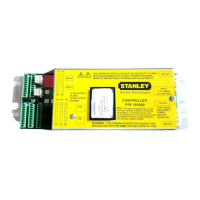204027
Rev. C, 11/9/05
Page 30 of 31
© 2005, THE STANLEY WORKS. ALL RIGHTS RESERVED.
Attachment 7
ANSI/BHMA and UL Compliance Requirements for Swinging and Folding Doors
(Sheet 2 of 2)
3.1 Wiring
3.1.1 To reduce the risk of electric shock proper and reliable grounding is mandatory. See Main Power Wiring instructions and Wiring Diagrams in this guide
for grounding techniques.
3.1.2 Permanent wiring is to be employed as required by the National Electrical Code and/or local codes.
3.1.3 Connection of external devices is shown in the wiring diagrams and terminal block layouts elsewhere in this guide. Refer to these figures for proper wiring
of external devices to ensure compliance with UL 325.
3.2 Knowing Act
Doors activated by a manual switch (Knowing Act switch in ANSI/BHMA terms) must have the switch installed in a location from which operation of the door can be
observed by the person operating the switch.
3.3 Entrapment - Swinging Doors
To ensure that a swinging door operates in accordance with UL 325 entrapment protection criteria the following must be established:
• Manual opening force or breakout force with power on or off must be less than 50 lbf (222.4 N).
• Closing force must be less than 40 lbf (177.9 N) at the lock/latch stile.
• Closing time through the final 10 degrees must be greater than 1.5 seconds.
• Maximum recommended door weight:
Magic-Access Operator = 250 lbs (115 kg)
Magic-Force Operator = 350 lbs (160 kg)
Magic-Swing Operator = 700 lbs (320 kg)
3.4 Entrapment – Folding Doors
To ensure that a folding door operates in accordance with UL 325 entrapment protection criteria the following must be established:
• Breakout force with power on or off must be less than 50 lbf (222.4 N).
• Closing force must be less than 30 lbf (133.4 N) between fully open and latch check.
• Closing time through the final 2 inches of closing (latch check) must be greater than 1.5 seconds measured at the lead edge of each FX (fold slide) panel.
• Maximum recommended door weight:
Bifold Door = 100 lbs (45 kg) each panel

